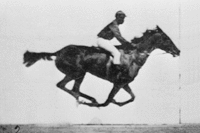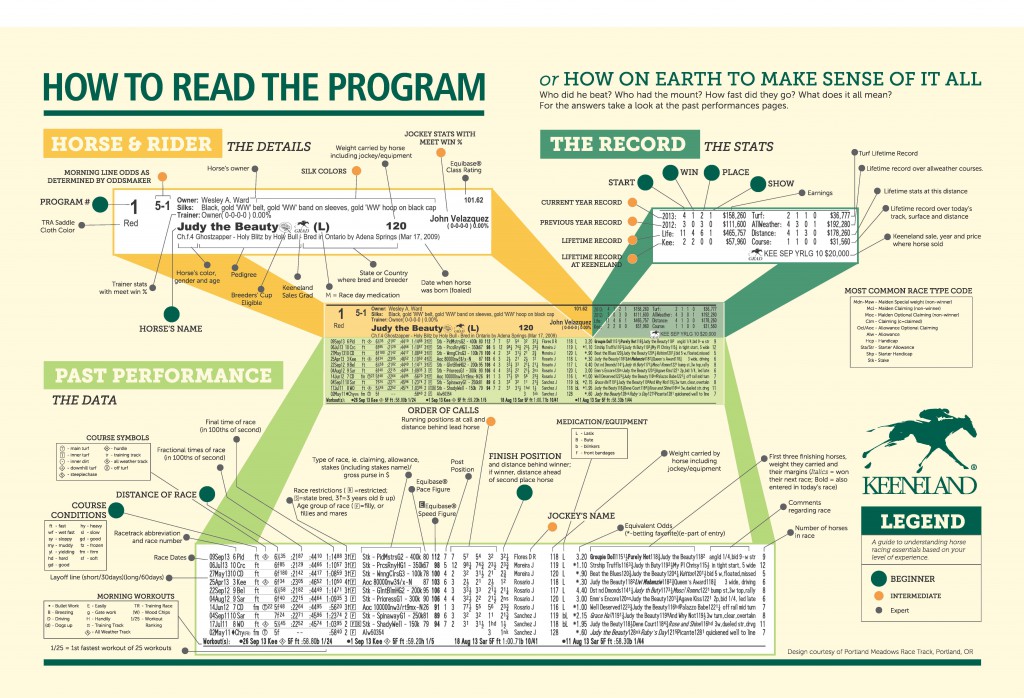How to Read a Horse Racing Form (Excellent site)
Horse Racing/How to Wager 101
Horse Racing Dictionary of Terms
Racing Terms National and International

From the Brits: US tracks follow.
- The race card, it normally is arranged as a line of numbers denoting finishing position or abbreviations. Form runs from left to right, with the oldest races on the left and the most recent on the right.
- The numbers 1-9 indicate the position the horse finished in the race.
- The number 0 indicates that the horse finished outside the first 9.
- The symbol - separates racing seasons. Numbers before the - are for last season.
- The symbol / indicates a longer gap, for example if the horse missed an entire racing season.
- P or PU indicates that the horse was pulled up by the jockey and did not complete the race.
- C indicates a horse has won on that course before.
- D indicates a horse has won over that distance before.
- CD indicates a horse has won over course and distance.
You may also see theses abbreviations:
United States (US) tracks:
Picking A Winner by Reading and Understanding the Racing Form
There is so much information packed into a horse racing form that it is dizzying, overwheling and confusing! By learning how to read the race card you will have information necessary about the horse's performace to enable you to make an informed decision when betting. However, there are so many variables in a horse's performace that the information provided is only a helpful overview of past and perhaps future performace. Below is helpful information to help you understand a Horse Racing Form for horses running on the flat on a track, i.e., not over jumps, etc.
"How to Read a Horse Racing Program
- The Records
- Past Performances
- Symbols and Abbreviations
What does a horse racing program look like?
The Racing Form or Race Card - Get on your reading glasses or have a magnifying glass near because the font is size 8! There is so much information provided in such a small space.

Image: Keenland Racetrack Infographic
Detailed info graphic created by Keeneland Racetrack
How to Read a Horse Racing Program"
- "Name, Jockey and Owner
- Designer Silks
- The only thing in a legible font on the program will be the horse's name.
- This will usually be accompanied with information about it's owner and rider.
- Additionally, the all important silks will be pictured in the margin.
- This little picture is probably the most important piece of information in this section as it will enable you to recognise your chosen horse when it is running around the track.
- If no picture is featured, then the silks will simply be described...
- Identifying silks is an easy way of verifying if a particular owner has any other horses running that day as typically every owner will have their signature patterns and colours....
Beginning Information to Understand:
- Checking the horse's name against the odds on the big screens
- Scanning through the rest of the program to see if the owner has raced any other horses and how they performed
- Spotting the jockey's silk so that you can watch the horse's behavior in the paddock before the race which can be an important indicator of performance...
Without getting bogged down in the details you can determine a lot from these simple snippets of information by doing the following things:
The Records...
- The first date will probably be the date of the current year and the numbers along from it will present the horse's yearly record
- The horses previous yearly records will be exposed...
- The life records will be shown
- You may get details on their performance on difference tracks such as Turf and All Weather
- You may also get details of the horse's value in dollars and the amount that they won per race
- For each category there will be 4 numbers, the second one is the number of wins which is the one to focus on...
Past Performances
- Date
- Race track abbreviation and race number
- Course Conditions
- Course Type
- Fractional time of race
- Final Time of race
- Race restrictions, ie handicap, age restrictions etc.
- Type of Race, ie stakes
- Post Position
- Order of calls-distance behind lead horse at various points during the race
- Finish Position
- Jockey's Name
- Weight carried including equipment
- Medical equipment
- Odds
- Weight carried by top 3 horses in the race
- Comments
- Number of horses in the race
- Results of Morning work out
- Wind Direction
In general you will be provided with the following details from left to right:
Extra details may include:
Take particular note of the details with italics. ...Although there will be a series of numbers detailing the order of calls, singling out the final number which will designate the horse's position at the finish line should be enough to make a judgement.
The other important facts are the race restrictions, course type and type of race. These are all variables which must match up with the race you are betting on to make your predictions as accurate as possible. The past performance results must be taken with a pinch of salt. Although they will give punters concrete facts to make their prediction often they can be misleading if you skim over the details....
Race Type Code
There are many different types are race codes, here are the three most common ones for top races:
Course Conditions and Course Symbols
...Beyond the horse and the jockey its important to consider what the terrain is like when you are analyzing and horse racing program. The course symbols are easy to overlook because they are designated by a series of very obscure abbreviations which can easily wash over a racegoer's head. If a horse won on a course which does not resemble the one they are racing on at a later date, then all bets will be off. After you have checked whether the horse's prowess is on Turf or Hurdle, it is important to verify the condition of the track. It may have been sloppy, muddy, hard or good, depending on the day. All of these minute details add up to create a complete picture of a successful horse.
-
The track condition symbols are the following:
- ft: fast (dry, even, resilient surface)
- wf: wet fast (track has surface water on it, but base is still solid. times are similar to, or sometimes faster than, a fast track. occurs immediately after a heavy rain)
- sy: sloppy (track has surface water on it, but base is still solid. times are similar to, or sometimes faster than, a fast track. occurs immediately after a heavy rain)
- my: muddy (a track that is wet but has no standing water)
- yl: yielding (Condition of a turf course with a great deal of moisture. Horses sink into it noticeably/a turf course with a significant amount of "give" to the ground due to recent rain)
- hd: hard
- gd: good a track that is almost fast) (for turf tracks/course slightly softer than firm)
- hy: heavy (Wettest possible condition of a turf course; not usually found in North America)
- sl: slow (Wettest possible condition of a turf course; not usually found in North America)(Not turf - slow: a track wet on both the surface and base)
- fz: frozen
- fm: firm (a firm, resilient surface for turf tracks)
- sf: soft (a turf course with a large amount of moisture. Horses sink very deeply into it
- s: sealed: A track surface that has been packed down. A sealed dry tracks allows water to run off the track, reducing the amount of precipitation absorbed. Wet tracks are sealed to provide a safe and even racing surface. The Daily Racing Form has recently added a "s" next to the track condition on the past performances if the track is sealed.
Race Restrictions...
This is only really important if a horse has just turned 3 and therefore has just begun to qualify for more challenging races. The four symbols you need to remember are:Medication and equipment symbols...
In practice this information is not required to secure a win. It is just useful to identify these symbols so that you are not thrown when you see these abbreviations on the program. If you are more advanced you may want to see whether a horse has improved automatically when they were put on Lasix or Bute.
Claiming Races - What is a claiming race? A race in which the horses are literally for sale. Any claims must be made before the race, and the new owner assumes possession following the race. ![]() Claiming Race/What is It?
Claiming Race/What is It?
For More Information:
Picking a winner by reading the formRacing Terms National and International
Claiming Race/What is It?

